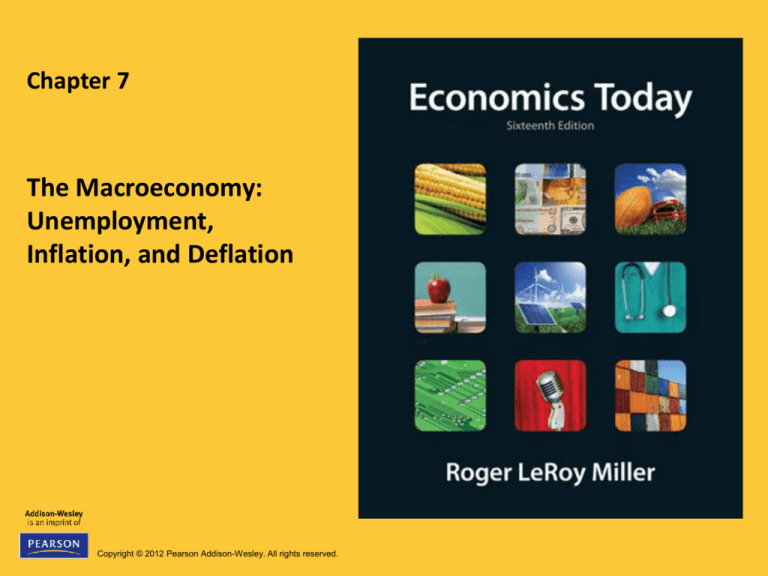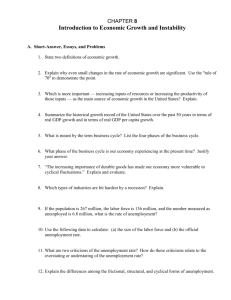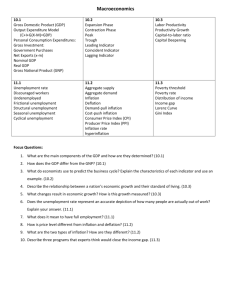
Chapter 7
The Macroeconomy:
Unemployment,
Inflation, and Deflation
Copyright © 2012 Pearson Addison-Wesley. All rights reserved.
Introduction
Economists track a misery index, which is the sum of
the unemployment rate—the percentage of the work
force out of work, and the inflation rate—the annual
percentage change in the average level of prices of
goods and services.
What should we make of the sharp upturn in the misery
index during the past few years?
This chapter will help you answer this question by
examining the unemployment rate and the inflation
rate.
Learning Objectives
• Explain how the U.S. government calculates
the official unemployment rate
• Discuss the types of unemployment
• Describe how price indexes are calculated and
define the key types of price indexes
Learning Objectives (cont'd)
• Distinguish between nominal and real interest
rates
• Evaluate who looses and who gains from
inflation
• Understand key features of business
fluctuations
Chapter Outline
• Unemployment
• The Major Types of Unemployment
• Full Employment and the Natural Rate of
Unemployment
• Inflation and Deflation
• Anticipated versus Unanticipated Inflation
• Changing Inflation and Unemployment:
Business Fluctuations
Did You Know That ...
• During the Great Recession of the late 2000s, about 80
percent of the more than 7 million people who lost their jobs
were male?
• Trying to understand determinants of unemployment and the
overall performance of the national economy is a central
objective of macroeconomics.
Unemployment
• Unemployment
– Total number of adults (aged 16 years or older)
willing and able to work and who are actively
looking for work but have not found a job
– Unemployment creates a cost to the entire
economy in terms of lost output – often ranging in
the billions of dollars
Unemployment (cont'd)
• Labor Force
– Individuals aged 16 years or older who either have
jobs or who are looking and available for jobs; the
number of employed plus the number of
unemployed
• The unemployment rate is the percentage of
the measured labor force that is unemployed
Unemployment (cont'd)
• Question
– What are the costs of unemployment?
Unemployment (cont'd)
• Answers
– Lost output
• At the end of 2000s, unemployment rate rose by 4
percentage points
• Firm output was 80% of potential
• Lost output was equivalent to $700 billion of goods and
services that could have been produced
– Personal psychological impact
• Hardship, failed opportunities and a lack of self-respect
Figure 7-1 More Than a Century of
Unemployment
Figure 7-2 Adult Population
Unemployment (cont'd)
Labor force = Employed
155.5*
=
141.3
+ Unemployed
+
Unemployed
Unemployment rate =
Labor force
14.2
x 100
14.2
x 100 = 9.1%
=
155.5
*U.S., millions of people; as of 2010
Unemployment (cont'd)
• Stock
– The quantity of something, measured at a given
point in time—for example, an inventory of goods
• Flow
– A quantity measured over time, such as the
income you make per year, or the number of
individuals fired every month
Unemployment (cont'd)
• Categories of individuals without work
– Job loser
– Reentrant
– Job leaver
– New entrant
Unemployment (cont'd)
• Job Loser
– An individual whose employment was
involuntarily terminated or who was laid off
• 40–60% of the unemployed
Unemployment (cont'd)
• Reentrant
– An individual who has worked a full-time job
before but left the labor force and has now
reentered it looking for a job
• 20–30% of the unemployed
Unemployment (cont'd)
• Job Leaver
– An individual who voluntarily quit
• 10 to 15% of the unemployed
Unemployment (cont'd)
• New Entrant
– An individual who has never worked a full-time
job for two weeks or longer
• 10 to 15% of the unemployed
Figure 7-3 The Logic of the
Unemployment Rate
Unemployment (cont’d)
• Duration of unemployment
– More than a third of job seekers find work within
one month
– Approximately another third find employment
within a second month
– About a sixth are still unemployed after six
months
– Average duration varied between 10 and 20 weeks
since the mid-1960s
Unemployment (cont'd)
• Question
– What is likely to happen to the duration of
unemployment during a downturn in the
economy?
Why Not … provide job losers with unemployment benefits
indefinitely?
• When the government provides unemployment benefits to
unemployed individuals, it reduces the incentive for them to
search seriously for a job.
• So, providing government unemployment benefits indefinitely
would boost the average duration of unemployment.
Unemployment (cont'd)
• Discouraged Workers
– Individuals who have stopped looking for a job
because they are convinced they will not find a
suitable one
• Question
– How does the existence of discouraged workers
bias the unemployment rate?
Unemployment (cont'd)
• Labor Force Participation Rate
– The proportion of non-institutionalized workingage individuals who are employed or seeking
employment
The Major Types of Unemployment
• The major types of unemployment
– Frictional
– Structural
– Cyclical
– Seasonal
The Major Types of Unemployment
(cont'd)
• Frictional Unemployment
– Results from the fact that workers must search for
appropriate job offers
– This takes time, so they remain temporarily
unemployed
The Major Types of Unemployment
(cont'd)
• Structural Unemployment
– Results from a poor match of workers’ abilities
and skills with current requirements of employers
– Considerable evidence shows that government
labor market policies influence how many jobs
businesses wish to create, thereby affecting
structural unemployment
The Major Types of Unemployment (cont'd)
• Cyclical Unemployment
– Results from business recessions that occur when
aggregate (total) demand is insufficient to create
full employment
The Major Types of Unemployment (cont'd)
• Seasonal Unemployment
– Results from the seasonal pattern of work in
specific industries
– Due to seasonal fluctuations in demand or
changing weather conditions that affect
agriculture, construction, tourism industries and
so on
International Example: A Source of “Nonregularity” in Japan’s
Cyclical Unemployment
• In Japan, “regular workers” usually have full-time jobs that
offer health care, retirement benefits and bonuses, and even
guarantees of employment for life.
• When the Great Recession engulfed the Japanese economy in
the later 2000s, the nation’s unemployment rate rose by 2
percentage points within 6 weeks.
• Most of the newly unemployed were “nonregular workers,”
who often are contract employees placed with firms by
employment agencies and earn much lower wages than those
for regular workers.
Full Employment and the Natural Rate
of Unemployment
• Questions
– Does full employment mean that everybody has a
job?
– Is it always possible for everyone who is looking
for a job to find one?
Full Employment and the Natural Rate
of Unemployment (cont'd)
• Full Employment
– An arbitrary level of unemployment that
corresponds to “normal” friction in the labor
market
Full Employment and the Natural Rate
of Unemployment (cont'd)
• Natural Rate of Unemployment
– The unemployment rate that is estimated to
prevail in the long-run macroeconomic
equilibrium
– Should not reflect cyclical unemployment
– When seasonally adjusted, the natural rate should
include only frictional and structural
unemployment
Inflation and Deflation
• Inflation
– A sustained increase in the average of all prices of
goods and services in an economy
• Deflation
– A sustained decrease in the average of all prices of
goods and services in an economy
Inflation and Deflation (cont'd)
• Purchasing Power
– The value of money for buying goods and services
– Varies with prices and income, e.g., if your money
income stays the same but the price of one good
goes up, your effective purchasing power falls
Inflation and Deflation (cont'd)
• Nominal value
– Price expressed in today’s dollars
• Real value
– Value expressed in purchasing power, adjusted for
inflation
Example: Rethinking Rankings of Top-Selling Films
• The entertainment media often compare a new film’s sales
against those of past movies using nominal ticket sales,
placing recent movies such as Titanic (1997), The Dark Knight
(2008), and Avatar (2009) as the top of the lists.
• But when all ticket sales are expressed in terms of the real
purchasing power of the dollar, rankings of top-selling movies
change dramatically: The top movies are now Gone with the
Wind (1939), The Sound of Music (1965), and Star Wars
(1977).
Inflation and Deflation (cont'd)
Measuring the Rate of Inflation
• Market Basket
– Representative bundle of goods and services
• Base Year
– The point of reference for comparison of prices in
other years
Inflation and Deflation (cont'd)
• Price Index
– The cost of today’s market basket of goods expressed as a
percentage of the cost of the same market basket during a
base year
cost of market basket today
Price index =
100
cost of market basket in base year
Table 7-1 Calculating a Price Index for a Two-Good
Market Basket
Inflation and Deflation (cont'd)
• Real-world price indexes
– Consumer Price Index (CPI)
– Producer Price Index (PPI)
– GDP deflator
– Personal Consumption Expenditure (PCE)
Inflation and Deflation (cont'd)
• Consumer Price Index (CPI)
– A statistical measure of a weighted average of
prices of a specified set of goods and services
purchased by wage earners in urban areas
– Market basket of goods and services of typical
consumer
Inflation and Deflation (cont'd)
• Producer Price Index (PPI)
– A statistical measure of a weighted average of prices of goods and
services that firms produce and sell
– Used as a short-run leading indicator (before CPI)
– Producer Price Indexes for:
• Foodstuffs
• Intermediate goods
• Finished goods
Inflation and Deflation (cont'd)
• GDP Deflator
– A price index measuring the changes in prices of
all new goods and services produced in the
economy
– Broadest measure of prices; reflects both price
changes and the public’s market responses to
those price changes
Inflation and Deflation (cont'd)
• Personal Consumption Expenditure (PCE)
Index
– A statistical measure of average price using
annually updated weights based on consumer
spending
– Primary inflation indicator used by the Federal
Reserve
Figure 7-4 Inflation and Deflation in
U.S. History
Anticipated versus Unanticipated
Inflation
• Anticipated versus unanticipated inflation
– To determine who is hurt by inflation we
distinguish between the two types
– The effects of inflation on individuals depend
upon which type of inflation exists
Anticipated versus Unanticipated
Inflation (cont'd)
• Anticipated Inflation
– The inflation rate that we believe will occur
• Unanticipated Inflation
– Inflation at a rate that comes as a surprise
Anticipated versus Unanticipated
Inflation (cont'd)
• Inflation and interest rates
– Nominal Rate of Interest
• The market rate of interest expressed in today’s dollars
– Real Rate of Interest
• The nominal rate of interest minus the anticipated rate
of inflation
Anticipated versus Unanticipated
Inflation (cont'd)
• Real interest rate
– Nominal interest rate = 5%
– Expected inflation rate = 3%
– Real rate = 5% – 3% = 2%
Anticipated versus Unanticipated
Inflation (cont'd)
• Does inflation necessarily hurt everyone?
– Inflation affects people differently
• Unanticipated inflation
– Creditors lose
– Debtors gain
Anticipated versus Unanticipated
Inflation (cont'd)
• Protecting against inflation
– Cost-Of-Living Adjustments (COLAs)
• Clauses in contracts that allow for increases in specified
nominal values to take account of changes in the cost of
living
Anticipated versus Unanticipated
Inflation (cont'd)
• The resource cost of inflation
– Repricing or Menu Cost of Inflation
• The cost associated with recalculating prices and
printing new price lists when there is inflation
Changing Inflation and Unemployment: Business Fluctuations
• Business Fluctuations
– The ups and downs in business activity
throughout the economy
Changing Inflation and Unemployment: Business Fluctuations
(cont'd)
• Expansion
– A business fluctuation in which the pace of
national economic activity is speeding up
• Contraction
– A business fluctuation during which the pace of
national economic activity is slowing down
Changing Inflation and Unemployment: Business Fluctuations
(cont'd)
• Recession
– A period of time during which the rate of growth
of business activity is consistently less than its
long-term trend or is negative
• Depression
– An extremely severe recession
Figure 7-5 The Idealized Course of Business
Fluctuations
Figure 7-6 National Business Activity,
1880 to the Present
Changing Inflation and Unemployment: Business Fluctuations
(cont'd)
• Leading Indicators
– Events that have been found to occur before
changes in business activity
• Economic downturns often follow
– Reduction in the average workweek
– Rise in unemployment insurance claims
– Decrease in prices of raw materials
– Drop in the quantity of money circulating
Example: Keeping Tabs on Economic Sentiment
• Dow Jones & Company recently began reporting an Economic
Sentiment Index (ESI) that gauges the degree of optimism
about the economy as gleaned from economic new articles in
15 major U.S. newspapers.
• Dow Jones contends that the ESI predicts future economic
performance and other leading economic indicators.
You Are There: A Family Restaurant Regretfully Boosts the
Unemployment Rate
• In the midst of the Great Recession of the late 2000s, the
Roussos Restaurant of Daphne, Alabama, which has served a
host of customers, including Jimmy Buffett and Elvis Presley,
became one of the over 6 million small businesses that have
closed since the end of 2007.
• The closing of these small businesses has contributed to a
sustained high U.S. unemployment rate.
Issues & Applications: Bad News from the Misery Index
• During the Great Recession of the late 2000s, the misery
index—the sum of the unemployment rate and inflation
rate—reached a level among the highest since the 1950s.
• Whether the misery index will continue to rise depends on
whether the upsurge in unemployment is mainly cyclical or
structural, and whether the rate of inflation remains relatively
low or increases.
Figure 7-7 The Misery Index Since the Early 1950s
Summary Discussion of Learning
Objectives
• How the U.S. government calculates the official
unemployment rate
– Percentage of the total number of adults willing and
able to work who are actively looking for work but
have not found a job
• The major types of unemployment
–
–
–
–
Frictional
Structural
Cyclical
Seasonal
Summary Discussion of Learning
Objectives (cont'd)
• Full employment
– Arbitrary level of unemployment
• Corresponds to “normal” friction in labor market
• Natural rate of unemployment
– Estimated to prevail in the long-run
macroeconomic equilibrium
• All workers and employers adjust to any changes in
economy
Summary Discussion of Learning
Objectives (cont'd)
• How price indexes are calculated and key price
indexes
– Multiply 100 times the ratio of the cost of a market
basket of goods in the current year to the cost of the
same basket in a base year
– Key price indexes
•
•
•
•
CPI
PPI
GDP deflator
PCE
Summary Discussion of Learning
Objectives (cont'd)
• Nominal versus real interest rates
– Nominal rate is the market rate expressed in
current dollars
– Real rate is net of inflation
– Hence the real interest rate equals the nominal
interest rate minus the expected inflation rate
Summary Discussion of Learning
Objectives (cont'd)
• Losers and gainers from inflation
– Creditors lose as a result of unanticipated inflation
– Borrowers gain
Summary Discussion of Learning
Objectives (cont'd)
• Key features of business fluctuations
– Increases and decreases in business activity
• Expansion from previous trough to new peak
• Contraction from previous peak to new trough









